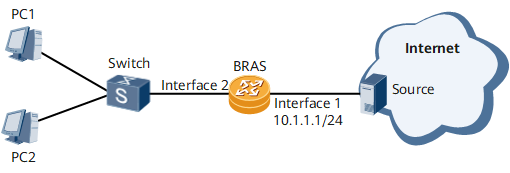Example for Configuring User-Side Multicast for PPPoE Access Users
This section provides an example for configuring user-side multicast for PPPoE access users.
Networking Requirements
On the network shown in Figure 1, users (with PC1 and PC2) are PPPoE access users, and they want to join multicast programs. Configure user-side multicast to implement user-based on-demand multicast data forwarding.
Configuration Roadmap
The configuration roadmap is as follows:
Configure an IPv4 address pool.
Configure Authentication, Authorization and Accounting (AAA) schemes.
Configure a domain.
Configure the PPPoE access mode:
Configure a virtual template (VT) interface.
Bind a VT to an interface.
Bind a sub-interface to a VLAN.
Configure a BAS interface and specify a user access type for the interface. (The interface can be a main, a common sub-interface, or a QinQ sub-interface. A common sub-interface is used in the example.)
Enable session-based multicast traffic replication on a BAS interface.
Configure basic multicast functions:
Enable multicast routing.
Enable PIM-SM on all BRAS interfaces.
Enable IGMP on the BRAS interface connected to users.
Data Preparation
IPv4 address pool
Authentication and accounting schemes
- User domain parameters
- VT number
- BAS interface parameters
Procedure
- Configure an IPv4 address pool.
<HUAWEI> system-view [HUAWEI] sysname BRAS [*HUAWEI] commit [~BRAS] ip pool huawei bas local [*BRAS-ip-pool-huawei] gateway 10.0.0.1 255.255.0.0 [*BRAS-ip-pool-huawei] section 1 10.0.0.1 10.0.255.255 [*BRAS-ip-pool-huawei] quit [*BRAS] commit
- Configure AAA schemes.
# Configure an authentication scheme.
[~BRAS] aaa [*BRAS-aaa] authentication-scheme none [*BRAS-aaa-authen-none] authentication-mode none [*BRAS-aaa-authen-none] quit [*BRAS-aaa] commit
# Configure an accounting scheme.
[~BRAS-aaa] accounting-scheme none [*BRAS-aaa-accounting-none] accounting-mode none [*BRAS-aaa-accounting-none] quit [*BRAS-aaa] quit [*BRAS] commit
- Configure a domain.
[~BRAS] aaa [*BRAS-aaa] domain ipv4 [*BRAS-aaa-domain-ipv4] authentication-scheme none [*BRAS-aaa-domain-ipv4] accounting-scheme none [*BRAS-aaa-domain-ipv4] ip-pool huawei [*BRAS-aaa-domain-ipv4] quit [*BRAS-aaa] quit [*BRAS] commit
- Configure a VT interface.
[~BRAS] interface virtual-template 100 [*BRAS-Virtual-Template100] ppp authentication-mode chap [*BRAS-Virtual-Template100] quit [*BRAS] commit
- Bind a sub-interface to a VLAN and specify a VT interface for the sub-interface.
[~BRAS] interface gigabitethernet 0/1/1.1 [*BRAS-GigabitEthernet0/1/1.1] user-vlan 2 [*BRAS-GigabitEthernet0/1/1.1-vlan-2-2] quit [*BRAS-GigabitEthernet0/1/1.1] pppoe-server bind virtual-template 100 [*BRAS-GigabitEthernet0/1/1.1] commit
- Configure a BAS interface and specify a user access type for the interface.
[~BRAS-GigabitEthernet0/1/1.1] bas [*BRAS-GigabitEthernet0/1/1.1-bas] access-type layer2-subscriber default-domain authentication ipv4 [*BRAS-GigabitEthernet0/1/1.1-bas] quit [*BRAS-GigabitEthernet0/1/1.1] commit
# Run the display access-user domain ipv4 command to display online user information. The command output shows that users with ID 1280 and 1281 accessed the Internet through PPPoE.[~BRAS] display access-user domain ipv4 ------------------------------------------------------------------------------ UserID Username Interface IP address MAC Vlan IPv6 address Access type ------------------------------------------------------------------------------ 1280 user@ipv4 GE0/1/1.1 10.0.255.251 00-e0-fc-32-34-56 -/- - PPPoE 1281 user@ipv4 GE0/1/1.1 10.0.255.250 00-e0-fc-12-34-56 -/- - PPPoE ------------------------------------------------------------------------------ Normal users : 2 RUI Local users : 0 RUI Remote users : 0 Total users : 2
- Enable session-based multicast traffic replication on a BAS interface.
[~BRAS-GigabitEthernet0/1/1.1] bas [*BRAS-GigabitEthernet0/1/1.1-bas] multicast copy by-session [*BRAS-GigabitEthernet0/1/1.1-bas] quit [*BRAS-GigabitEthernet0/1/1.1] quit [*BRAS] commit
- Configure basic multicast functions.
[~BRAS] multicast routing-enable [*BRAS] interface gigabitethernet 0/1/0 [*BRAS-GigabitEthernet0/1/0] undo shutdown [*BRAS-GigabitEthernet0/1/0] ip address 10.1.1.1 255.255.255.0 [*BRAS-GigabitEthernet0/1/0] pim sm [*BRAS-GigabitEthernet0/1/0] quit [*BRAS] commit [~BRAS] interface gigabitethernet 0/1/1.1 [*BRAS-GigabitEthernet0/1/1.1] pim sm [*BRAS-GigabitEthernet0/1/1.1] igmp enable [*BRAS-GigabitEthernet0/1/1.1] quit [*BRAS] commit
- Verify the configuration.# Run the display multicast group-ip command to display information about users of a specified multicast group. The command output shows that users with ID 1280 and 1281 joined a multicast program whose group address is 225.0.0.1.
[~BRAS] display multicast group-ip 225.0.0.1 out-interface GigabitEthernet 0/1/1.1 User ID User IP User type Interface 1280 10.0.255.251 Local GigabitEthernet0/1/1.1 1281 10.0.255.250 Local GigabitEthernet0/1/1.1 Local user number :2 Remote user number:0 Total user number :2
# Run the display multicast user-id command to display information about the multicast programs that a specified user joined on a BAS interface. The following example uses the command output for user 1280.[~BRAS] display multicast user-id 1280 User information: User ID :1280 User IPv4 address :10.0.255.251 Gateway IPv4 address:10.0.0.1 BRAS interface :GigabitEthernet0/1/1.1 User MAC-address :00-e0-fc-22-34-56 MAX program list :4 User order program: Group IP Source IP 225.0.0.1 0.0.0.0 Total:1
# Run the display pim routing-table command to display PIM routing entries.[~BRAS] display pim routing-table VPN-Instance: public net Total 1 (*, G) entry; 1 (S, G) entry (*, 225.0.0.1) RP: NULL Protocol: pim-sm, Flag: WC NIIF UpTime: 01:37:51 Upstream interface: NULL, Refresh time: 01:37:51 Upstream neighbor: NULL RPF prime neighbor: NULL Downstream interface(s) information: Total number of downstreams: 1 1: GigabitEthernet0/1/1(bas) Protocol: igmp, UpTime: 01:37:51, Expires: - (10.1.1.100, 225.0.0.1) RP: NULL Protocol: pim-sm, Flag: SPT LOC ACT UpTime: 04:34:52 Upstream interface: GigabitEthernet0/1/0, Refresh time: 04:34:52 Upstream neighbor: NULL RPF prime neighbor: NULL Downstream interface(s) information: Total number of downstreams: 1 1: GigabitEthernet0/1/1(bas) Protocol: pim-sm, UpTime: 01:37:51, Expires: -
Configuration Files
# sysname BRAS # multicast routing-enable # ip pool huawei bas local gateway 10.0.0.1 255.255.0.0 section 1 10.0.0.1 10.0.255.255 # aaa # authentication-scheme none authentication-mode none # accounting-scheme none accounting-mode none # domain ipv4 authentication-scheme none accounting-scheme none ip-pool huawei # interface Virtual-Template100 ppp authentication-mode chap # interface GigabitEthernet0/1/0 undo shutdown ip address 10.1.1.1 255.255.255.0 pim sm # interface GigabitEthernet0/1/1.1 user-vlan 2 pppoe-server bind Virtual-Template 100 pim sm igmp enable bas # access-type layer2-subscriber default-domain authentication ipv4 multicast copy by-session # return

